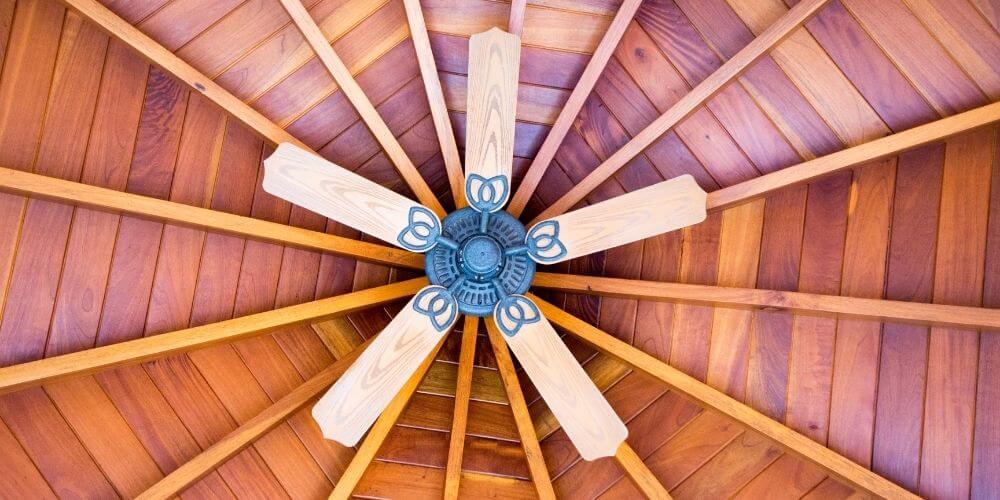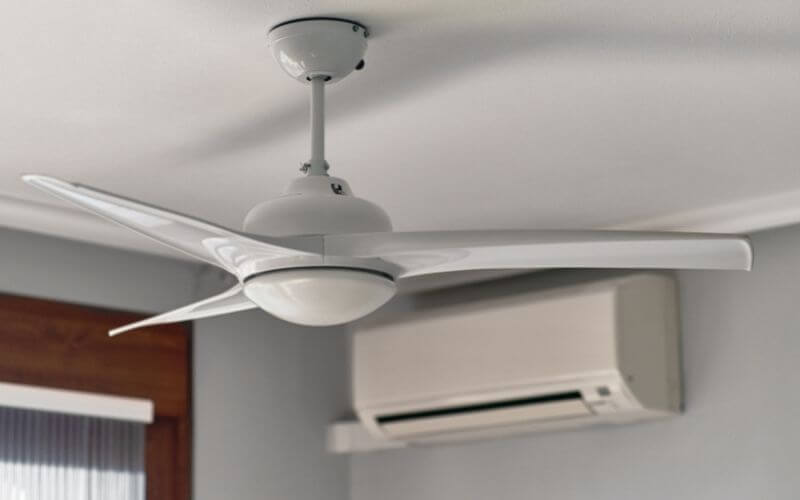In summer, it’s not uncommon to have ceiling fans running all day and night in most of the rooms of your home. So you may be curious to know how much electricity ceiling fans use.

When you know how much each ceiling fan is adding to your monthly energy bill, you can make an informed decision about when to run them on high, when to switch to low, and whether you should, in fact, be using another cooling method like air conditioning or a standing fan.
The good news is, that ceiling fans probably don’t use as much electricity as you might think. They’re pretty efficient at circulating the airflow and keeping us cool. So, read on for all the stats and figures…
How Many Watts Does A Ceiling Fan Use?
Wattage means refers to the amount of electricity used by a device at any single instant in time. Electricity usage over time is measurde in watt-hours (wH) or kilowatt-hours (kWh).
Most ceiling fans draw between 15 and 90 watts of electricity, with the average using 50 watts. Over the course of an hour, a ceiling fan on a high setting will use about 50 watt-hours of electricity, which equates to 0.05 kWh.
People will often say that energy usage depends on the size of the ceiling fan, but that’s a myth. The usage won’t depend on the size of your ceiling fan but it will depend on the setting you choose.
The lowest setting will help you conserve electricity, but it won’t have the same effect as the highest power setting on your fan.
How Much Electricity Does A Ceiling Fan Use Per Hour?
The average ceiling fan uses 50 watt-hours of electricity per hour, but it could be anywhere between 15 and 90 watt-hours depending on the model of fan. This isn’t a lot, as other appliances like TVs and refrigerators use more.
Suggested read: How Much Electricity Does A TV Use?
Does Keeping A Ceiling Fan On All Night Use A Lot Of Electricity?
Keeping your ceiling fan all night doesn’t use a lot of electricity, particularly if it’s set to a low speed. Eight hours of ceiling fan usage over the course of a night will use an average of 0.4 kWh of electricity. This is much less than other cooling appliances like air conditioners.

How Much Does It Cost To Run A Ceiling Fan?
On average, running a ceiling fan costs less than one cent per hour. This is based on a 50-watt fan using 0.05 kWh of electricity and the average cost of electricity in the United States, which is $0.14 in 2022.
Of course, the real cost of running your ceiling fan for an hour will depend not just on the model of the fan, but on exactly how much you pay for electricity.
This table from the US Energy Information Administration shows that while $0.14 is the average price per kWh for residential electricity in the United States, this varies quite a lot by state. In Hawaii, for example, electricity costs around $0.34 per kWh.
To work out how much an appliance costs per hour, you can use this formula:
Kilowatts X Cost of Energy
So
0.05 x 14 cents = 0.7 cents per hour
Ceiling Fan Cost Calculator
You can use this calculator to work out the exact cost of running your ceiling fan. if you know the wattage and your electricity rate, enter those. Otherwise, the calculator already contains the averages.
How Much Does It Cost To Run A Ceiling Fan For A Day?
Running a ceiling fan for 12 hours in the day will cost around 8 cents on average. However, the actual cost could be anywhere from 2 cents to 37 cents, depending on the wattage of the fan and how much the supplier charges for electricity.
How Much Does It Cost To Run A Ceiling Fan All Night?
Running a ceiling fan for 8 hours at night on the highest setting costs around 6 cents on average. However, if you use a lower setting at night, you can easily half your electricity usage and therefore the cost.
How Much Does It Cost To Run A Ceiling Fan 24/7
The average ceiling fan costs around $5 per month to run if you leave it on a high setting 24/7. If you have a particularly powerful fan and pay a higher than average rate for your power, a single fan could add up to $20 to your monthly bill.
It’s not wise to leave your ceiling fan on 24/7. You can save energy by only using it when you’re in the room and by using the lowest speed setting that you need.
Do Ceiling Fans Raise Electricity Bills?
Using any electrical appliance will raise your electricity bill, but the good news is that ceiling fans are generally pretty cheap to run. If you switch to using a ceiling fan instead of an air conditioner, you will find that our monthly electricity bills will fall considerably.
Suggested read: Air Conditioner Vs Fan Electricity Usage
On the whole, running an electric ceiling fan should only cost a couple of dollars each month. Many people would say that this is a small price to pay during a hot and humid summer.

Does Using A Ceiling Fan Save Electricity?
Using ceiling fans instead of air conditioning can save you up to $200 per month on electricity. While the exact savings will vary depending on your usage and the rate that you pay for electricity, a saving of around $1000 over the summer is certainly achievable for many families.
Should You Leave Ceiling Fans On When You’re Not In The Room?
You should always turn off the ceiling fan whenever you leave a room. Ceiling fans don’t actually cool rooms, they just circulate the air. It’s the feeling of air moving over your skin that makes you feel cooler. So, a ceiling fan in an empty room is doing nothing except wasting electricity.
Is A Ceiling Fan Worth it?
If you’re considering installing ceiling fans in your home then you’ll want to think carefully about whether they’re worth it. Sure, they’re much cheaper to run than AC, but you also have to factor in the cost of the fan and the cost of the installation.
If you don’t live in a particularly warm climate, you may find that you don’t need to use a ceiling fan that often as leaving windows open may be enough to keep your home cool on all but the hottest days. In that case, you may find that a portable standing fan is a better solution, as you can just buy one and move it around the house with you.
Suggested read: How Much Electricity Does A Standing Fan Use?

Ceiling Fan FAQs
Ceiling fans are designed to run for very long periods of time, so you can leave them running continuously for years without worrying about them breaking. While it is safe to run a ceiling fan continuously, running a fan with nobody in the room is a waste of electricity.
In the summer, your ceiling fan should run counterclockwise to push air down and create a cool breeze. In the winter, running it clockwise at a low speed will redistribute warm air away from the ceiling and around the room.
A ceiling fan uses around 50 watts of electricity, which is slightly less than a 60-watt incandescent lightbulb but considerably more than the equivalent LED lightbulb which uses only 10 watts.
A ceiling fan on its highest speed setting will use much more electricity than a low setting. Running a fan at half speed will use around half of the energy as running it on full speed.
